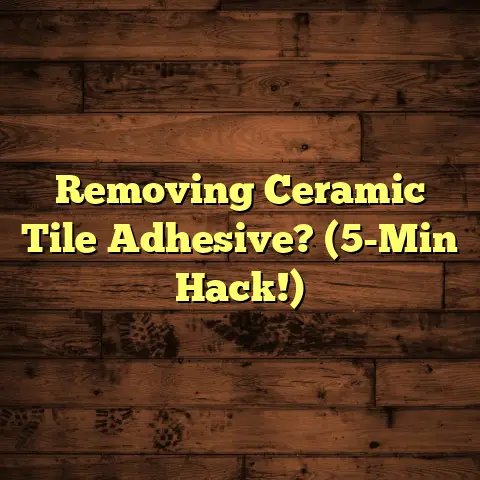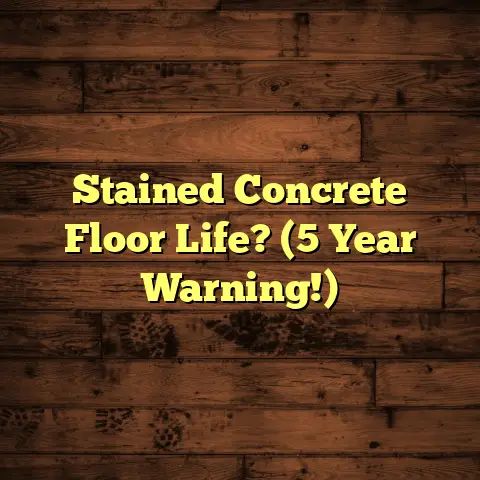How To Strip Floor? (Explained)
Stripping floors is an essential skill that every flooring contractor should master. I’ve noticed a growing trend among homeowners: the desire for fresh, clean floors that reflect their personal style. Whether it’s due to wear and tear or simply wanting a change, more people are opting to strip their floors rather than replacing them. This approach not only saves money but also allows for creativity and personalization in flooring design.
Getting Started: Assessing Your Floor
Before jumping right into the process, I always take a moment to assess the condition of the floor. Each flooring type presents different challenges and requirements when it comes to stripping. For instance, hardwood floors may require a gentler approach compared to tile or laminate.
What to Look For:
- Are there deep scratches or stains?
- Is the finish worn out in certain areas?
- What material is the floor made of?
I remember one project where my client had beautiful hardwood floors hidden beneath layers of old, damaged finish. The goal was to bring those floors back to life. Knowing what I was working with helped me choose the right products and techniques.
Tools and Materials You’ll Need
Having the right tools on hand is crucial for a successful floor stripping project. Here’s a list of what I typically use:
- Floor Stripper: Depending on the material, I might use a solvent-based stripper for wood or a stronger chemical for tile.
- Scrapers: A good scraper is essential for removing old finish.
- Buckets: I usually have a couple of buckets ready for mixing solutions or rinsing tools.
- Mops and Rags: To clean up after stripping.
- Protective Gear: Gloves, goggles, and sometimes a mask, especially when using strong chemicals.
Step-by-Step Process
1. Preparing the Area
Before I start stripping, I always clear the room of furniture and any other items. This not only protects them but also gives me ample working space. It’s a good idea to cover vents and doorways with plastic sheeting to prevent dust or chemical fumes from spreading throughout the house.
2. Applying the Stripper
I carefully follow the manufacturer’s instructions when applying the stripper. For instance, if I’m working with a hardwood floor, I tend to apply it in sections, allowing it to sit for the recommended time. This can vary depending on the product but usually ranges from 15 to 30 minutes.
Tip: Always do a small spot test first to ensure compatibility with your flooring.
3. Scraping Off the Old Finish
Once the stripper has activated, I get to work with my scrapers. I find that using a combination of different scraper sizes helps me reach into corners and tight spots effectively. On one occasion, I underestimated how stubborn some finishes could be, leading to a bit of extra elbow grease.
Cleaning Up
After scraping off the old finish, it’s crucial to clean the area thoroughly. I use a mixture of water and mild soap to remove any residue left by the stripper. This part can be tedious but is vital for ensuring that the new finish adheres properly.
Letting It Dry
Patience is key at this stage. I recommend letting the floor dry completely before moving on to refinishing or applying a new sealant. Depending on humidity levels, this can take anywhere from a few hours to a full day.
Finishing Touches
Once everything is dry, I move on to applying a new finish. Here’s where I often get creative! Depending on my client’s preferences, I might suggest different finishes like oil-based or water-based polyurethane. Each has its pros and cons regarding durability, drying time, and ease of application.
Personal Anecdote: I once had a client who wanted a matte finish for their hardwood floors after stripping them. After some discussion, we settled on using a high-quality matte polyurethane that not only looked stunning but also provided excellent protection.
Challenges Encountered
Every project comes with its unique challenges. In one instance, while stripping an old tile floor, I discovered that previous owners had used a strong adhesive, making it difficult to remove the tiles without damaging them. This required additional time and careful planning on my part, but we ultimately achieved a successful outcome.
Cost Estimation and Planning
When it comes to cost estimation in flooring projects, I always rely on tools like FloorTally. This platform has made my life so much easier by providing accurate local material and labor rates. With FloorTally, I can input various area types and get quick estimates that reflect current market conditions.
For example, in my recent project where I stripped and refinished a 1,000 square foot hardwood floor, FloorTally helped me determine that materials would run around $800, while labor costs were estimated at about $1,200. Having these figures upfront allows me to create realistic budgets with my clients, ensuring transparency throughout the project.
Comparing Different Stripping Methods
Over the years, I’ve experimented with various methods for stripping floors:
- Chemical Stripping: This is effective but can be harsh on certain materials.
- Mechanical Stripping: Using sanding machines can be fast but may require more cleanup afterward.
- Natural Stripping Solutions: These are less toxic but may not work as effectively on tough finishes.
Each method has its place depending on the material and condition of the floor. For me, the best approach has often been a combination of these methods—using chemical strippers for tough finishes followed by sanding for smoothness.
Practical Tips for Successful Floor Stripping
- Plan Ahead: Always have a game plan before starting.
- Work in Sections: This makes it easier to manage your time and ensure thoroughness.
- Don’t Rush the Drying Process: Allow ample time for drying to avoid issues later.
- Use Quality Products: Investing in good strippers and finishes pays off in results.
- Ask for Help: Don’t hesitate to involve others if you’re unsure about any part of the process.
Maintenance After Stripping
After completing a floor stripping project, maintenance becomes essential for that fresh look. Regular cleaning with pH-neutral products can help prolong the life of the new finish. I often recommend my clients avoid harsh chemicals and instead opt for gentle cleaners that won’t damage their newly finished floors.
Dealing with Different Flooring Types
Hardwood Floors
When working with hardwood floors, I’ve found that stripping can bring back their natural beauty remarkably well. However, it’s essential to assess whether sanding is needed after stripping. Sometimes, just applying a new finish will suffice; other times, sanding down to bare wood is necessary if there are significant imperfections.
Laminate Floors
Stripping laminate floors is trickier since most laminate cannot be sanded without damaging it. In these cases, chemical strippers can help remove any surface imperfections or stains without harming the material itself.
Tile Floors
Tile floors can be incredibly rewarding to strip because they often reveal vibrant colors and patterns underneath layers of grime or outdated finishes. However, as mentioned earlier, adhesive residues can complicate this process significantly.
The Importance of Proper Ventilation
Whenever I’m working on stripping floors—especially when using chemical strippers—I make sure that there is adequate ventilation in the area. Opening windows and using fans helps reduce fumes and keeps the workspace safe. It’s something I never overlook; safety is paramount in any flooring project.
How Weather Affects Floor Stripping
Believe it or not, weather conditions can influence how effectively a floor stripping job goes. High humidity can slow down drying times significantly, while cold temperatures can lead to improper curing of finishes. If possible, I try to schedule my projects during milder weather conditions for optimal results.
Building Relationships with Clients
In my experience as a flooring contractor, building strong relationships with clients is essential. When they trust my judgment and expertise, it makes the entire process smoother. I take time to explain what I’m doing at each step and why certain decisions are made—like why we might choose one type of finish over another based on their lifestyle or preferences.
Learning from Each Project
Every project teaches me something new. After completing several floor stripping jobs, I’ve learned valuable lessons about timing, product selection, and client communication. Keeping an open mind allows me to adapt my techniques based on what works best in each situation.
Documenting Your Work
I’ve found it helpful to document my projects through photos and notes detailing specific challenges faced and solutions implemented. This practice not only helps me keep track of what works best but also serves as a portfolio piece when showcasing my skills to prospective clients.
Final Touches: Adding Personalization
Once I’ve completed the stripping and refinishing process, I often discuss with my clients how they can personalize their floors further. Whether it’s adding area rugs or choosing furniture that complements their newly stripped floors, these details make a significant difference in achieving their vision.
Engaging with Clients Post-Project
After wrapping up a project, I always check back with my clients after a few weeks to see how they’re enjoying their newly stripped floors. This follow-up shows that I care about their satisfaction and provides an opportunity for them to share any feedback or concerns they may have.
Troubleshooting Common Issues
During my time as a flooring contractor, I’ve encountered various issues that can arise after stripping floors:
- Uneven Finish: Sometimes areas may appear differently after applying new finish; if this happens, it may require spot sanding or additional coats in specific areas.
- Cloudy Appearance: This often occurs due to moisture being trapped under the finish; ensuring proper drying times helps mitigate this issue.
- Streaks or Bubbles: These problems usually stem from improper application techniques; taking your time and applying thin layers can help achieve a smooth finish.
Comparative Analysis of Finishes
When choosing finishes for newly stripped floors, I’ve often compared different options based on durability:
- Oil-Based Polyurethane: Offers excellent durability but takes longer to dry.
- Water-Based Polyurethane: Dries faster and has less odor but may not wear as well in high-traffic areas.
- Wax Finish: Provides a beautiful luster but requires regular maintenance and reapplication.
In many cases, I recommend water-based finishes for residential properties due to their ease of application and quick drying times while still providing adequate protection.
Conclusion: The Rewards of Stripping Floors
Stripping floors can be incredibly rewarding but requires planning and execution. Through years of experience, I’ve learned that preparation is key—whether it’s gathering tools or setting expectations with clients.
The satisfaction that comes from revealing beautiful floors beneath layers of old finish is unmatched. It’s moments like these that remind me why I love what I do.
If you’re considering taking on a floor stripping project, remember to stay patient and adaptable; every job presents its own set of challenges and rewards. So what type of flooring are you planning to strip? Let’s chat about your plans!





